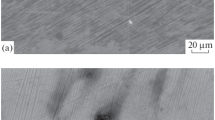Abstract
Titanium alloys approved for clinical use in Russia are widely used in traumatology, maxillofacial surgery, and stomatology, mainly for manufacturing various endoprostheses and dental implants, i.e., structures to be introduced and installed into the bone and soft tissues of the human organism, capable of both biointegration and bioadaptation in the tissues of the human organism. In the field of medicinal material science, particularly, in designing structures for medicinal use based on titanium and its alloys and also various coatings on the surface of such structures, the modern methods and instruments developed for the electronic industry are being widely used. The methods designed for investigating materials and structures in electronics are employed in medicinal technology and particularly in the development of titanium implants. This makes it possible to develop the fundamentals for the technology of preparing the optimal microrelief on the surface of titanic endoprostheses intended for engrafting in soft tissues (i.e., fibrointegrable) and covered by bioactive coatings of titanium dioxide (TiO2) with the anatase structure obtained by atomic-layer deposition. The research is aimed at revealing the optimal surface treatment of such endoprostheses in order to achieve improved fibrointegration properties for using them in maxillofacial surgery. It is shown that the strong adhesion and fibrointegration between the titanium endoprosthesis and the connective tissue are achieved at the average surface roughness of (4–8) × 102 nm, the root-mean-square roughness of (5 × 102–1 × 103) nm, a profile height of (3–6) × 103 nm, and a thickness of the bioactive coatings of the order of magnitude of 10 nm.







Similar content being viewed by others
REFERENCES
Liu, X., Chu, P.K., and Ding, C., Surface modification of titanium, titanium alloys, and related materials for biomedical applications, Mater. Sci. Eng. A, 2004, vol. 47, pp. 49–121. doi 10.1016/j.mser.2004.11.001
Titanium in Medicine: Materials Science, Surface Science, Engineering, Biological Responses and Medical Applications, Brunnette, D.M., Tengvall, P., Textor, M., and Thomsen, P., Eds., Berlin: Springer, 2001.
Steinemann, S.G., Titanium—The materials of choice?, Periodontology, 1998, vol. 17, pp. 7–21. doi.org/ 10.1111/j.1600-0757.1998.tb00119.x
Hauert, R., Thorwarth, G.B., and Thorwarth, K., An overview on diamond-like carbon coatings in medical applications, Surf. Coat. Technol., 2013, vol. 233, pp. 119–130. doi.org/10.1007/s10853-015-8833-3
Roy, R.K. and Lee, K.R., Biomedical applications of diamond-like carbon coatings: a review, J. Biomed. Mater. Res., B, 2007, vol. 83, no. 1, pp. 72–84. doi 10.1002/jbm.b.30768
Hauert, R.A., A review of modified DLC coatings for biological applications, Diamond Rel. Mater., 2003, vol. 12, no. 3, pp. 583–589. doi 10.1016/S0925-9635(03)00081-5
Poole, Ch. and Owens, F., Introduction to Nanotechno-logy, Hoboken, NJ: Wiley, 2003.
Heinrichs, J., Jarmar, T., Rooth, M., and Enqvist, H., In vitro bioactivity of atomic layer deposited titanium dioxide on titanium and silicon substrates, Key Eng. Mater., 2008, vols. 361–363, pp. 689–692. doi.org/ 10.4028/www.scientific.net/KEM.361-363.689
Alekhin, A.P., Markeev, A.M., Tetyukhin, D.V., Kozlov, E.N., and Stepanova, M.A., Influence of physical and chemical properties of titanium implant surface and methods of their modification on osseointegration indices, Klinich. Stomatol., 2009, no. 3, pp. 3–5.
Alekhin, A.P., Vrublevskii, A.I., Markeev, A.M., Roma-nov, R.I., and Nevolin, V.N., On the structure and properties of amorphous carbon films formed by the magnetoactive microwave plasma deposition, Poverkhnost’, 1996, no. 10, p. 47.
Zhao, G., Schwartz, Z., Wieland, M., Rupp, F., Geis-Gerstorfer, J., Cochran, D.L., and Boyan, B.D., High surface energy enhances cell response to titanium substrate microstructure, J. Biomed. Mater. Res., A, 2005, vol. 74, pp. 49–58. doi.org/10.1002/jbm.a.30320
Yamamoto, D., Kawai, I., Kuroda, K., Ichino, R., Okido, M., andSeki, A. Osteoconductivity and hydrophilicity of TiO2 coatings on Ti substrates prepared by different oxidizing processes, Bioinorg. Chem. Appl., 2012, vol. 2012, p. 495218.
GOST (State Standard) No. 19807-91, Wrought titanium and titanium alloys. Grades.
ASTMF 67Gr3 Standard specification for unalloyed titanium, for surgical implant applications (UNS R50250, UNS R50400, UNS R50550, UNS R50700).
Alekhin, A.P., Boleiko, G.M., Gudkova, S.A., Markeev, A.M., Sigarev, A.A., Toknova, V.F., Kirilenko, A.G., Lapshin, R.V., Kozlov, E.N., and Tetyukhin, D.V., Synthesis of biocompatible surfaces by nanotechnology methods, Nanotechnol. Russ., 2010, vol. 5, nos. 9–10, pp. 696–708.
Shaihaliev, A.I., Krasnov, M.C., Il'ina, A.P., Yamskova, O.V., Rybakova, E.Yu., Sventskaya, N.V., Beletsky, B.I., Yamskova, V.P., and Yamskov, I.A., The effect of the chemical nature of implant materials on regeneration processes in an implant site, Biophysics, 2016, vol. 61, no. 4, pp. 687–695.
Shaikhaliev, A.I., Stretskii, G.M., Krasnov, M.S., Rybakova, E.Yu., Tikhonov, V.E., Yamskova, V.P., and Yamskov, I.A., Effect of new compositions on restoration of bone defects in rats in experiment, Fundam. Issled., 2013, no. 9 (2), pp. 271–276.
GOST (State Standard) No. 25142-82, Surface roughness. Terms and definitions.
ISO 4287:1997, Geometrical Product Specifications (GPS), Surface texture: Profile method—Terms, definitions and surface texture parameters.
ASME B46.1-1995, Surface Texture (Surface Roughness, Waviness, and Lay).
GOST (State Standard) No. R ISO 10993.5-99. Medical devices. Biological evaluation of medical devices. Part 5. Tests for cytotoxicity: in vitro methods.
Center for Collective Use Materials Science and Metallurgy NUST MISiS. http://misis.ru/business/materials-science/.
ACKNOWLEDGMENTS
These studies were carried out with the use of equipment of the Center of Collective Use Material Science and Metallurgy of the National Research Technological University, Moscow Institute of Steel and Alloys [22].
Author information
Authors and Affiliations
Corresponding author
Additional information
Translated by T. Ya. Safonova
Rights and permissions
About this article
Cite this article
Shaikhaliev, A.I., Polisan, A.A., Ivanov, S.Y. et al. Methods for Studying Materials and Structures in Electronics as Applied to the Development of Medicinal Endoprostheses of Titanium with Enhanced Fibroinegration Efficiency. Russ Microelectron 47, 575–582 (2018). https://doi.org/10.1134/S1063739718080103
Received:
Published:
Issue Date:
DOI: https://doi.org/10.1134/S1063739718080103




